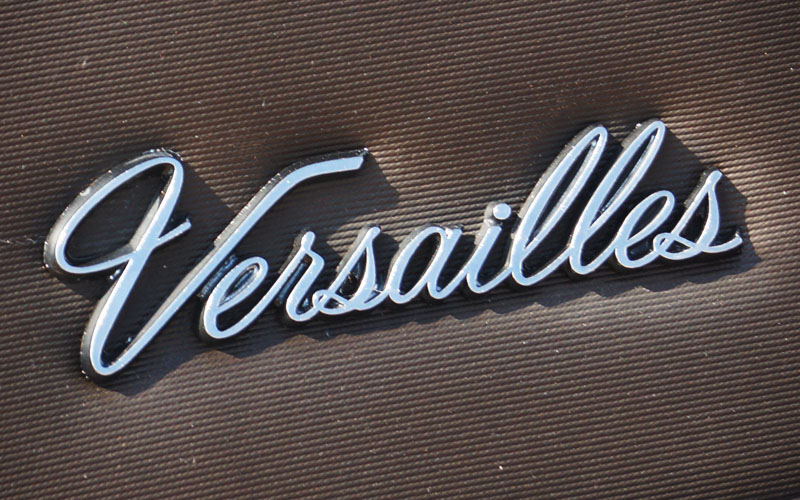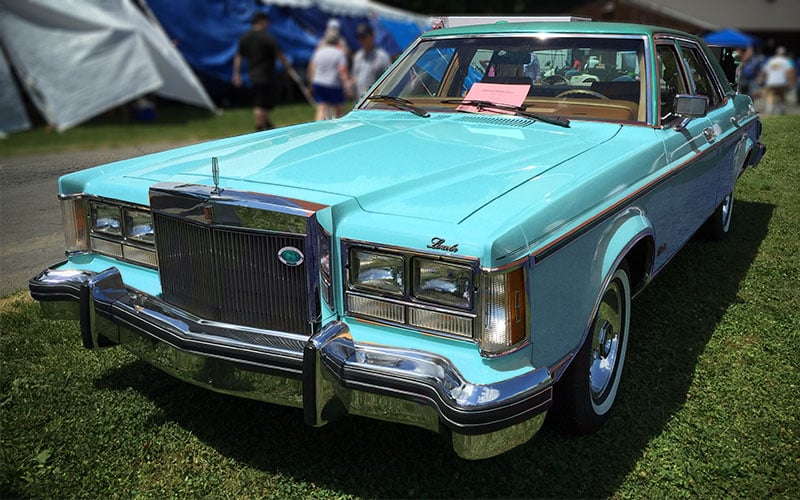
The Lincoln Versailles was introduced by Ford as a response to General Motor’s success with the Cadillac Seville. Detroit in the early seventies was a city with few secrets, so it’s doubtful that anyone at Ford was particularly surprised by the arrival of the “international-sized” 1975 Cadillac Seville. The price, however, came as a shock to everyone, being considerably above that of the DeVille and Eldorado. Charging more money for “less car” must have seemed like a ridiculous idea, but it was also a successful one. Customer response was strong, as were sales. Lincoln dealers sounded the alarm: get us a small car! In a hurry!
The 1977 Lincoln Versailles was just that: a small sedan and delivered in a hurry. But with that haste came some consequences. The name had a smattering of history with Ford, having been used briefly overseas and also receiving some brief consideration during consumer clinics for the car that became the Continental Mark III – but most customers likely saw it as simply a response to the Seville, which also used the name of a Western European city to signify international cachet to the domestic audience.
The Seville shared very little in the way of styling or dimensions, as it was based on the Chevrolet Nova platform. And Ford didn’t have the time for significant changes so the Versailles, from the Ford Granada on which it was based, arrived with just a few changes – hood, front and rear fascia, trunk.
The good news was that the Granada, unlike the Nova, was already “internationally styled,” with flat sides and formal styling based on the W114-generation Mercedes-Benz sedan. True, the Versailles was awfully busy, and Baroque-looking compared to the sleek Seville, but that was true of pretty much every Ford and Mercury at the time. It was obviously a Lincoln from ahead and behind, if not from the side, where only a unique padded vinyl roof and a coach light on the B-pillar gave the game away.

At $11,500 the Versailles had the highest base price of any Lincoln. Even with that price tag it was a $1,000 cheaper than the Cadillac Seville and $600 less than a Mercedes-Benz 240D (with an automatic transmission). The list of standard equipment on the Versailles was extraordinary for the day. From standard air conditioning (A/C on the Benz 240D was a $898 upgrade) to leather seats and to a hand-buffed clearcoat finish, this was a first for American automobiles. Another rarity: forged aluminum wheels in an era of “steelies” and wire covers, no doubt inspired by the “Bundt” wheels made by Fuchs for Mercedes-Benz. The 351 V-8 did not have fuel injection to match the Seville’s injected Oldsmobile 350, but in magazine tests of the era, the Lincoln was slightly faster. Four-wheel discs were standard, with a 9-inch Ford rear diff that would often be stripped by drag racers from junkyard-bound examples.
Contemporary reviewers were impressed by the Lincoln’s paint, smooth ride, quiet interior, and exemplary build quality. But the visual similarities to the Ford Granada, and its Mercury Monarch sibling, were hard for customers to swallow. After a strong debut year of 15,434 sales, the Versailles fell to 8,931 in 1978, just over a quarter of the Seville’s volume.
A bit of visual distance needed to be put between the Versailles and the aging Granada, but Ford’s budget was tied up (and then some) trying to get the new-generation Fox and Panther platforms out the door during a recession.
The solution came from an unusual place: American Sunroof Corporation, or ASC, and its mercurial founder, Heinz Prechter. When Ford contacted him to develop ideas for the 1979 Versailles, he and his team spent ten days of round-the-clock work developing a “formal look” roofline, then drove the prototype to a party being held at the home of Gene Bordinat, Ford’s head of design. It was a big hit, to put it mildly.
Every 1979 and 1980 Versailles was modified by ASC after the fact, using a fiberglass “cap” riveted to the existing metal roof and covered by padded vinyl. The cap didn’t affect rollover safety and it permitted the use of larger door glass. The effect was remarkable, and remarkably convincing. It was accompanied by another domestic industry first: quad halogen headlamps. 1979 was the biggest year for Versailles, with over 21,000 units sold.
1980, by contrast, was dismal. The recession was in full swing, but more importantly than that there was a new Continental sedan on the Panther platform with razor-crisp styling and fuel economy to match the Versailles. Only 4,784 examples of the 1980 Versailles were sold and the car was discontinued for 1981. Lincoln dealers were forced to go a year without a compact sedan, a situation that was rectified in 1982 with the Fox-based Continental. That car bore all the marks of hard lessons learned by Lincoln during the four years of Versailles production; it had unique styling inside and out, bearing absolutely zero resemblance to the Fairmont, Granada, and Thunderbird with which it shared a platform.
The strengths of the Versailles – build quality, solid powertrain – ended up leading to the demise of many examples. They were often driven into the ground then stripped of their drivelines by budget-minded hot-rodders and racers. In an era of creased panels and “aero” styling, the Versailles was not particularly prized by collectors, so very few cars were preserved.
Happily, the Versailles is now experiencing a bit of a renaissance thanks to a new generation of collectors. The Lincoln and Continental Owners Club (LCOC) now reports that Versailles of all years are showing up in good condition at the meets and shows. Late in 2022, a solid example of an early-roofline Versailles did well in an online auction.

As a classic and collector car, the Versailles has a lot to recommend it. They really were built well compared to many cars of the era. The high level of standard equipment means that almost any Versailles you find will be worth preserving. And both of the V-8 powertrains are easily capable of keeping up with modern traffic, as are the four-wheel discs. It is a relatively light and compact car, easy to park and store. Even the once-controversial styling now shines in an era of bulbous five-door SUVs; it has a certain dignity and presence that’s hard to find now.
Despite all of this, prices are still reasonable, and parts are still relatively easy to get – ironically, in some cases they are more readily available than those for the compact Continental that succeeded it. The classic car market, just like Detroit in the Seventies, has few secrets. Right now, but maybe not for long, the Lincoln Versailles is still one of them.

Leave A Comment